
table of contents
- Types from A - D
- Types of E - F
- Species with G
- Types of H - K
- Types from L - M
- Types of N - R
- Types with S
- Types from T - Z
- frequently asked Questions
Around 7,000 different species of beetles live in Germany, some of which differ greatly in their appearance and way of life. In this article, we will introduce you to some domestic beetles.
In a nutshell
- numerous types in different sizes and colors
- many predatory species
- some also eat flower parts, pollen or tree sap
- others live on or in the water
- Larvae often found in the soil as grubs
Types from A - D
Beam shredder (Dorcus parallelipipedus)

- Length: 20 to 32 millimeters
- Appearance: matt black color, wrinkled elytra, finely dotted head and pronotum, males with strong upper jaws
- Way of life: feeds mainly on tree sap
- Larva: develops in rotten or dead wood within 2 to 3 years
Bee beetle (Trichodes apiarius)
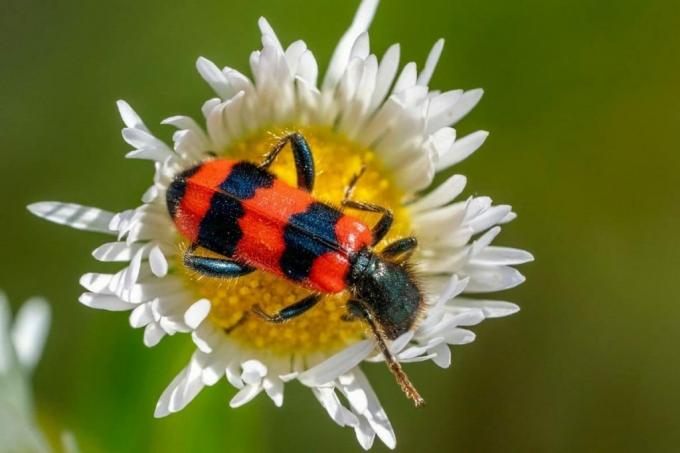
- Length: 9 to 15 millimeters
- Appearance: wing-coverts bright red with three black transverse bands, the posterior touching the end of the wing, conspicuous hairs
- Way of life: predominantly predatory
- Larva: predatory, lives in bees' nests and eats their larvae and pupae
The nicely drawn bee beetle belongs to the family of colored beetles and is also known as the beetle or the wolf.
Note: The very similar shaggy bee beetle (Trichodes alvearius) is a little less common, but the third black cross band does not touch the end of the wing.
Letterpress printer (Ips typographus)
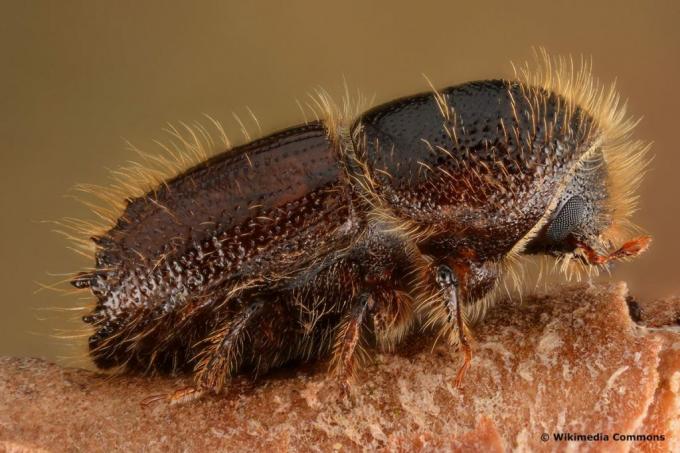
- Length: 4 to 5 millimeters
- Appearance: reddish brown with clear, protruding hair, small teeth at the rear end
- Way of life: in spruce wood, characteristic feeding tunnels, feared forest pest
- Larva: in spruce wood, maggot-like, legless, only a few days to fully develop
Nettle leaf weevil (Phyllobius pomaceus)

- Length: 6 to 8 millimeters
- Appearance: entire body covered with greenish, shiny scaly hair, short proboscis
- Way of life: often on nettles
- Larva: living on the ground, feeds on plant roots
Types of E - F
Oak leaf roller (Attelabus nitens)
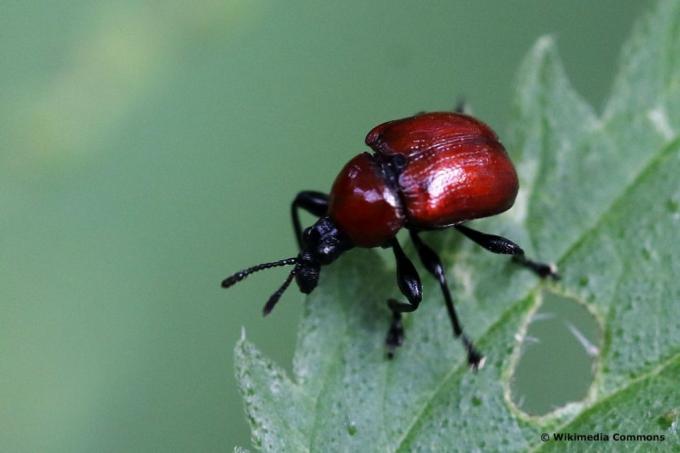
- Length: 4 to 7 millimeters
- Appearance: brown, head and legs black, antennae reddish at the base
- Way of life: feeds on oak leaves
- Larva: develops in curled oak leaves
Alder leaf beetle (Agelastica alni)

- Length: 6 to 7 millimeters
- Appearance: blue-black, blue-violet, dark blue or greenish colored, females with thick, egg-filled abdomen
- Way of life: feed on alder leaves
- Larva: black, lives in groups on alder leaves
Field tiger beetle (Cicindela campestris)
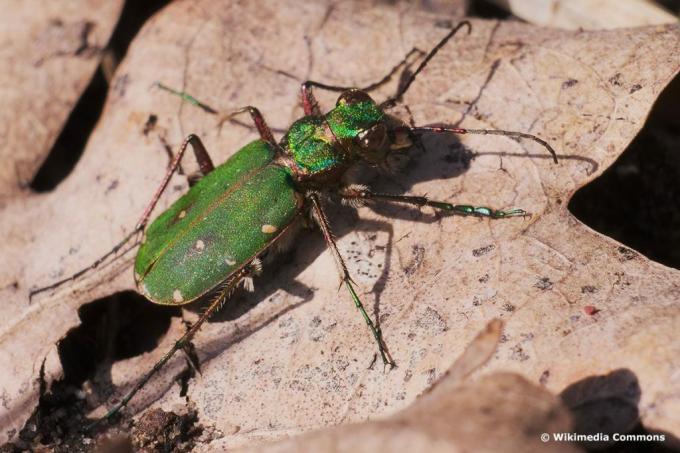
- Length: 10 to 16 millimeters
- Appearance: metallic green color with point-like spots, large, protruding eyes, long and pointed upper jaw
- Way of life: predatory
- Larva: lives predatory, lives in self-dug, vertical earth tubes
The species is particularly active in strong sunlight in gravel pits, on sandy beaches, dry slopes, on paths, fields and in heathland areas.
Species with G
Garden beetle (Phyllopertha horticola)

- Length: 8 to 12 millimeters
- Appearance: Head and pronotum shiny green, elytra reddish brown, whole body densely hairy
- Way of life: eats leaves and flowers
- Larva: lives in the soil as a grub and is considered a pest
Jellyfish beetle (Dytiscus marginalis)

- Length: 27 to 35 millimeters
- Appearance of males: wing-coverts glossy dark green and smooth, pronotum and wing-coverts with conspicuous yellow marginal stripes
- Appearance females: greenish brown with deep longitudinal furrows
- Way of life: predatory, lives in water
- Larva: approx. five to seven millimeters long, lives predatory
The pretty yellow fire beetle is a common native beetle that can be found in both stagnant and slow-flowing waters.
Common shovel runner (Cychrus caraboides)
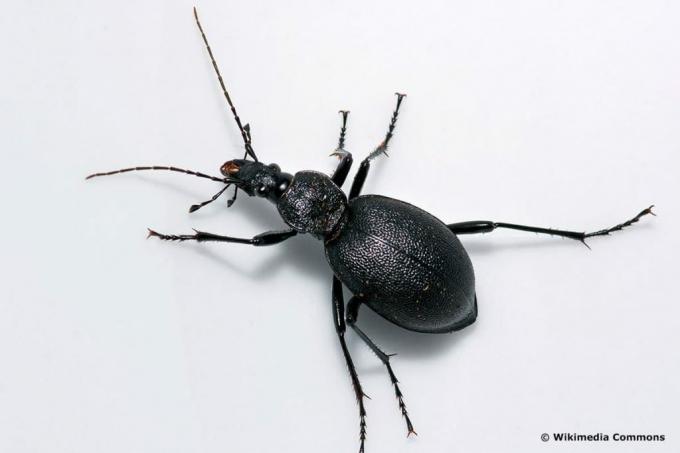
- Length: 12 to 20 millimeters
- Appearance: shiny black, wing-covers slightly wrinkled, long, remarkably narrow head with elongated mouthparts
- Way of life: predatory, crepuscular and nocturnal
- Larva: lives predatory, assel-like appearance
Both the larva and the adult beetle mainly eat nudibranchs and snails, which is why the species is a welcome beneficial insect both in agriculture and in the garden.
Note: The narrow shovel runner (Cychrus attenuatus) offers a risk of confusion, but can be distinguished by its light bronze shimmer in color.
Firefly (Lamprohiza splendidula)

- Length: 8 to 10 millimeters
- Appearance of males: dark brown color, head hidden under pronotum, finely wrinkled elytra
- Appearance females: similar to larvae, unable to fly, light color
- Larva: similar to assel, feeds mainly on snails
Between June and July, the male fireflies fly through the twilight as tiny will-o'-the-wisps to find the females, who often sit in the grass. The egg and larva also produce a faint glow.
Gold beetle (Carabus auratus)
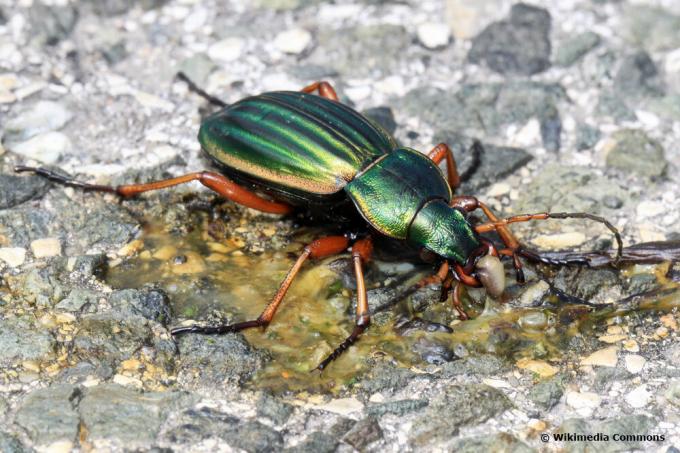
- Length: 17 to 30 millimeters
- Appearance: shiny gold-green top, reddish legs and antenna segments
- Way of life: predatory
The species, also known as the gold hen or goldsmith, is a very common one domestic beetle that hunts herbivorous insects and their larvae and is therefore a beneficial insect is classified.
Note: The shiny gold ground beetle (Carabus auronitens) looks quite similar, although it is a little darker in color. In addition, the wing-cover ribs of this species are colored black instead of gold-green as in the gold beetle.
Types of H - K
Hazelnut borer (Curculio nucum)

- Length: 6 to 9 millimeters
- Appearance: entire body black, white and gray scales, almost body length, curved trunk, kneeling antennae on the trunk
- Way of life: native beetle widespread in forests and parks
- Larva: develops in hazelnuts and eats the core
Stag beetle (Lucanus cervus)

- Length: 30 to 75 millimeters
- Appearance of males: powerful, antler-like pincers on the head, head and pronotum black, wing covers brown
- Appearance females: solid black, only has short pincers
- Way of life: adult beetles lick tree sap
- Larva: Development time 5 to 8 years, in rotten oak
Largest domestic beetle, which is also dependent on the occurrence of old oaks. The endangered species is under strict protection.
June beetle (also ribbed curl beetle, Amphimallon solstitiale)
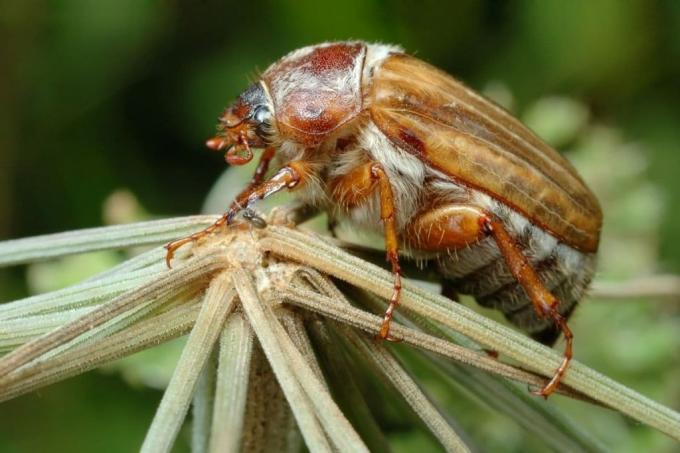
- Length: 14 to 18 millimeters
- Appearance: light brown, slightly translucent elytra, densely hairy, 3-part antennae
- Way of life: feeds on leaves and flowers
- Larva: 4 to 5 centimeters long, as a grub in the ground
Piston water beetle (Hydrophilus piceus)

- Length: 30 to 43 millimeters
- Appearance: glossy black
- Way of life: eats fresh leaves and algae, able to fly
- Larvae: up to seven centimeters long, mainly eat snails
This water beetle usually lives hidden between aquatic plants and only comes to the surface of the water to take a breath. He then carries his air supply with him as a shiny air bubble on his stomach. If you catch it, it bites painfully.
Note: A domestic beetle that is, however, endangered and therefore strictly protected. Removal from the garden pond (or anywhere else) is not permitted!
Types from L - M
Leather beetle (Carabus coriaceus)
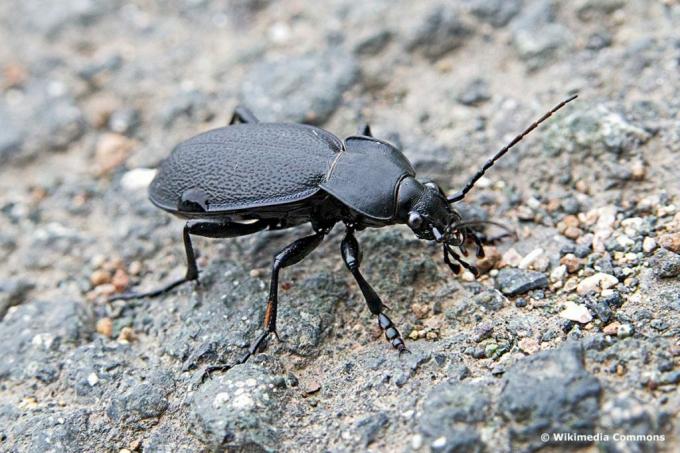
- Length: 30 to 41 millimeters
- Appearance: black, wing-coverts wrinkled leather-like, large maxillary forceps
- Way of life: predatory, also the larva
- Larva: pupates in the ground, hatches from May as a complete beetle
The largest species of ground beetle in Central Europe cannot fly and is predominantly nocturnal. In the event of danger, the species sprays caustic butyric acid up to a meter.
Cockchafer (Melolontha melolontha)
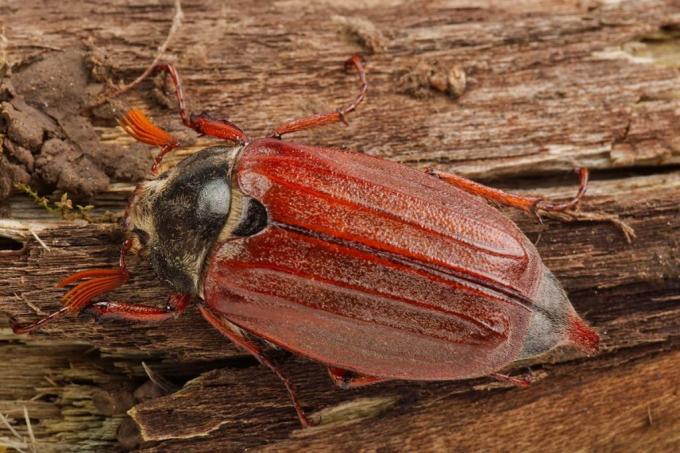
- Length: 20 to 30 millimeters
- Appearance: shiny, brown wing covers, black pronotum, abdomen drawn out to a point, whitish, triangular spots on the sides of the abdomen
- Way of life: feeds on leaves, especially oaks
- Larva: approx. 5 to 6 millimeters long, lives as a grub in the root area of plants
Matter Pill Twist (Sisyphus schaefferi)
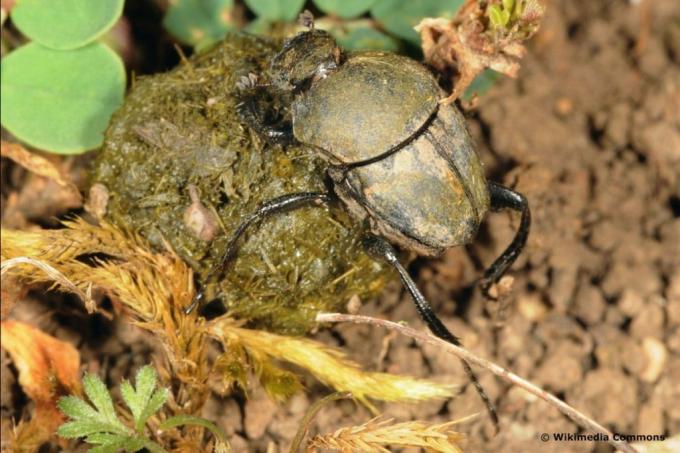
- Length: 8 to 12 millimeters
- Appearance: dark brown to black, strongly arched, pointed body, long, curved hind legs, front legs designed as grave legs
- Way of life: produces feces from animal excrement and buries them in the ground
- Larva: develop on buried fecal balls
Note: Domestic beetle, which is however endangered and therefore under strict protection.
Flour beetle (Tenebrio molitor)

- Length: 12 to 18 millimeters
- Appearance: glossy chestnut brown to black, longitudinal grooves on the elytra, finely dotted pronotum
- Way of life: colonizes human surroundings, prefers dark and warm places
- Larva: up to 4 centimeters long, worm-like appearance, feared storage pest
Types of N - R
Rhinoceros beetle (Oryctes nasicornis)

- Length: 25 to 40 millimeters
- Appearance: dark brown, males with a long, curved head horn
- Way of life: lives in rotting organic material (e.g. B. Compost rent)
- Larva: with a length of up to 12 centimeters, the largest beetle larva in Europe, development time 3 to 5 years
A native beetle, which has now become very rare and is therefore under strict protection.
Oil beetle (Meloidae spec.)
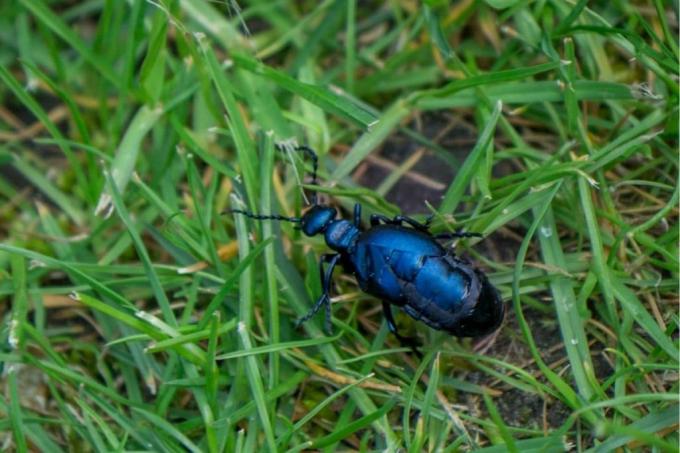
- Length: 10 to 35 millimeters
- Appearance: blackish-blue, shiny color, strongly swollen abdomen, short, gaping elytra
- Way of life: feeds on parts of plants, unable to fly
- Larva: lives in earth bee nests and eats bee eggs
This, too, is a common native beetle that can be found mainly in heat-favored biotopes such as dry grassland, forest edges and on sandy soils.
Rose chafer (Cetonia aurata)
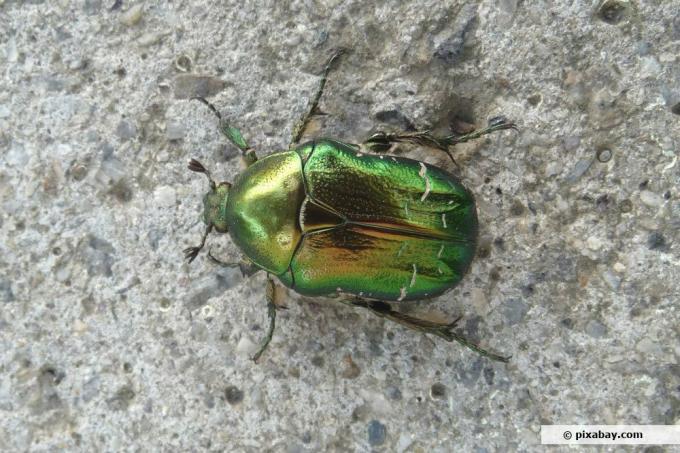
- Length: 14 to 20 millimeters
- Appearance: shiny green, brown or bronze metallic with white spots, antennae thickened like a club
- Way of life: feeds on flower parts and pollen
- Larva: feeds mainly on wood mulm, often found in compost
The sun-loving rose beetle especially flies to the blossoms of roses, fruit trees, elderberries and umbelliferous plants, making a loud humming sound in flight.
Red and yellow soft beetle (Rhagonycha fulva)
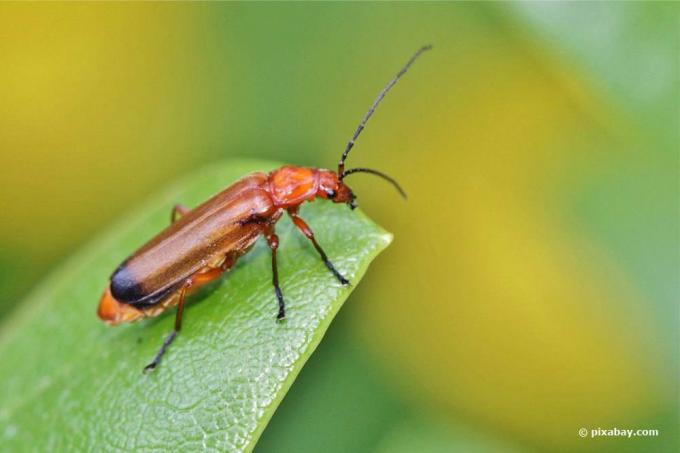
- Length: 7 to 10 millimeters
- Appearance: Head, pronotum and elytra brownish red, tips of the elytra blackish, long, thin antennae
- Way of life: mainly predatory
- Larva: velvet brown in color, eats snails and worms
This pretty beetle is considered extremely useful because it eats large quantities of plant-damaging insects.
Types with S
Scarlet Fire Beetle (Pyrochroa coccinea)

- Length: 14 to 18 millimeters
- Appearance: pronotum and wing covers bright red, hairy like velvet, head, antennae and legs black
- Way of life: lives on plant juices and the honeydew of aphids
- Larva: yellowish brown, slightly flattened, under loose bark and in rotten wood
Note: Since the larva also eats bark beetle larvae, it is considered a beneficial insect in forestry.
Black mold beetle (Ocypus olens)
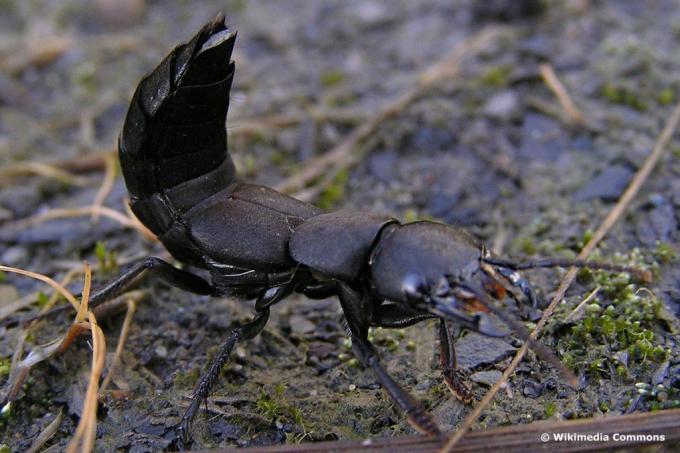
- Length: 20 to 32 millimeters
- Appearance: black, very short wing-coverts, elongated body, large head, short antennae
- Way of life: predatory
Widespread native beetle that takes a typical defensive stance when threatened: the abdomen is bent forward and the mandibles spread to bite. In addition, the animal can secrete a foul-smelling secretion.
Black-horned gravedigger (Nicrophorus vespilloides)
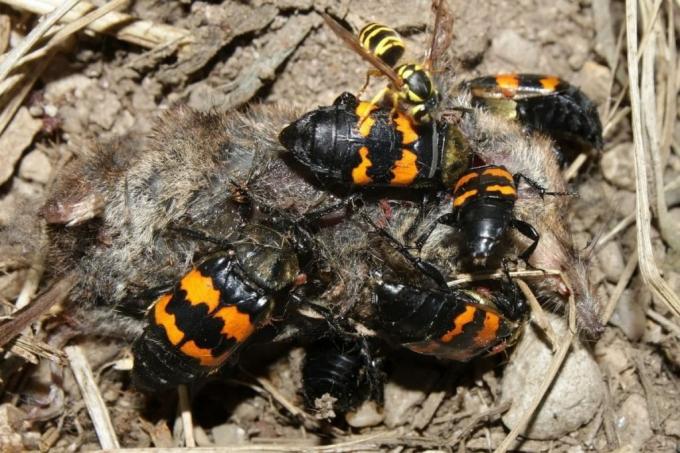
- Length: 10 to 18 millimeters
- Appearance: black color with 2 orange-red cross bars on the wing covers
- Way of life: scavengers, "forest health police"
The grave digger, which is widespread throughout Europe, bears his name for a reason: dead animals in the forest (e. B. Mice) are practically buried in the ground by these beetles. The buried animal carcass in turn serves as food for the beetle offspring.
Soldier beetle (Cantharis fusca)
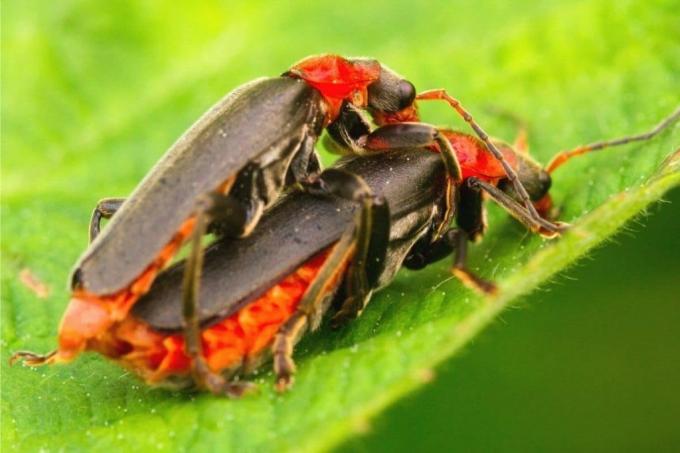
- Length: 11 to 15 millimeters
- Appearance: dark wing-coverts with velvety hair, red pronotum with black spot, reddish abdomen
- Way of life: mainly predatory
- Larvae: approx. two centimeters long, colored velvety black
Another common domestic beetle is the soldier beetle, which belongs to the soft beetle family. You can usually see the soldier beetle sitting on flowers or leaves in the sunshine, where it eats aphids and other small insects. The mostly diurnal larva is also very popular with gardeners because it eats snails.
Types from T - Z
Tumbler beetles (Gyrinidae)
- Length: 5 to 7 millimeters
- Appearance: shiny black, regular rows of dots on the elytra
- Way of life: predatory
- Larvae: approx. 15 millimeters long, lives in the bottom of the water
The formation of swarms, which can be observed particularly well on sunny days, is typical of the 20 different European wobble beetle species. Then the beetles turn in droves in fast circles on the surface of the water, which is what earned them the species name.
Forest dung beetle (Anoplotrupes stercorosus)

- Length: 12 to 19 millimeters
- Appearance: greenish to bluish, shiny metallic, strong legs with thorns and barbs
- Way of life: eats animal excrement
- Larva: in 30 to 40 centimeters deep ground tubes filled with excrement, feed on the store of excrement
Dainty jewel beetle (Anthaxia nitidula)

- Length: 5 to 7 millimeters
- Appearance of males: solid green, shiny metallic
- Appearance females: like males, only with copper-red head and pronotum
- Way of life: eats pollen and flower petals
- Larva: develops under the bark of fruit trees
This and other jewel beetles can be found mainly on sunny edges of forests, in bushes and orchards.
frequently asked Questions
The characteristic antler pincers are only worn by male stag beetles, which - just like the real deer - fight against each other for the much more inconspicuous females.
So-called longhorn beetles, which include the large oak buck, musk buck, alpine buck, red-necked buck or the real Rambock belong, are characterized by a very narrow body and long, in some species even well over body length, Feeler off.
If you find thick, white grubs in the compost, you will be happy about it: These are by no means pests. Instead, the larvae ensure that the compost rots better and are therefore very useful. Do not leave the larvae in the light for too long as they cannot tolerate UV radiation and die quickly.



